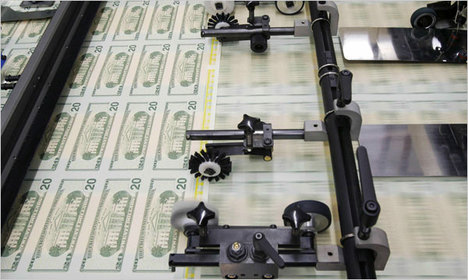With the Federal government scheduled to shut down on April 8, Congress is not only debating where to spend trillions of dollars in the next fiscal year, but also whether to raise the roof, i.e. the debt ceiling. The debt ceiling simply represents a cap on the total debt the U.S. government can hold, and it is currently set at a whopping $14.294 trillion. Though the resolution for this limit was signed a mere year ago, we are quickly approaching the limit and should reach it sometime in the first week of April. Keep in perspective that it would take more than 31,000 years of earning $1 a day to make a measly $1 trillion of the total debt. The government has added to the total debt every year since 1960 (except for two years). Worse yet, it has added over $5 trillion in the past three and a half years alone. Wouldn’t common sense indicate that there’s little room to borrow more? Apparently not.
The reality is that many lawmakers want to “stabilize the debt” by increasing the debt ceiling. Of course, you can’t stabilize trillions of dollars. So essentially, the government ends up selling more bonds just to pay interest on the national debt and pay for new spending. What’s a few more hundred billion when you already owe several trillion?
Often, to explain how we must increase the debt ceiling, government plays on one major fear – the fear of U.S. default. Those in support of raising the debt ceiling argue that if it’s not increased the government will not be able to meet obligations. They essentially say the country will go bankrupt. To prevent this very issue, the debt ceiling has been raised 74 times since March 1963. The problem with this rationale is that it’s like urging a boat to take on more water to keep it from sinking. Imagine meeting with your financial planner and hearing him say, “In these tough financial times I recommend you add to your debt in order to stay solvent.” I hope you would quickly find a new financial planner.
In the realm of “real world” spending, consumers cannot increase their total debt with a simple declaration. As consumers approach a high level of debt, their ability to take on more debt is checked by the price (interest rates) and the risk premium they represent to a possible lender. Obviously, no mechanism of natural market discipline exists for government. So instead, the debt ceiling becomes an artificial barrier which is put in place to demonstrate the illusion of fiscal responsibility. Opponents of raising the debt ceiling agree.
When the debt ceiling is reached, it will be the first time we’ve done so without raising the limit. Though there will be implications, don’t expect a government shutdown. For one, the treasury will be unable to borrow more money to meet federal government obligations. Scary? Absolutely, but it might not be a bad thing considering no legislation to date has worked to curb out of control spending. Congress would likely have to pass legislation mandating that the first checks the government writes each month pay for debt service, which would undoubtedly leave fewer dollars available for all other spending. (In a dream world this repercussion would lead government to tighten their belts and make cost effective saving measures). What is certain is that a failure to raise the debt ceiling would not result in government default. Congress has more than enough at its disposal to pay U.S. Treasury bond obligations. The fear of default is misguided.
In a March 30 Wall Street Journal column, U.S. Senator Marco Rubio wrote that he (and others) will only vote to raise the debt ceiling if it’s the last raise ever made and if its accompanied by several measures to tighten and reign in spending. With such emphatic promises from political heavyweights like Rubio, you can bet on a hot debate in coming days.

COMMENTS
Please let us know if you're having issues with commenting.